In rural Morocco, weaving and rug making is women’s business. Weaving is as much part of their lives as is childcare, household chores and cooking. Making a carpet involves much more work, time and effort than just sitting in front of a loom all day.
From rearing the animals to processing the wool to making the carpet is a long and arduous journey. Live wool, shorn from a sheep, has to be washed, carded, combed, spun, and dyed before it is ready to go into a carpet. This can take weeks or months of work.
Once the wool is ready, setting up a loom and designing a carpet is a whole new job that takes intelligence and artistic flair.
Pile rugs have complicated designs, which means that weavers have to count the threads to make the patterns come out right. “It is the brain that works. Whatever design your eyes see, you have to figure it out.” Sometimes Fadma borrows designs from her earlier rugs or from decorative elements on old buildings. Sometimes she creates a design from nature – a flower in the field or an insect’s footprint.
The design evolves as Fadma works on the loom. “As you’re weaving, it becomes clear what you’ll put in the rug. Even if you’ve already chosen the designs, you think about what you might add. The main thing is to make the rug pretty, to decorate it so that it will look really nice and everyone who sees it will say, “What a good woman!”
Excerpt from Women Artisans of Morocco by Susan Schaefer Davis, p17
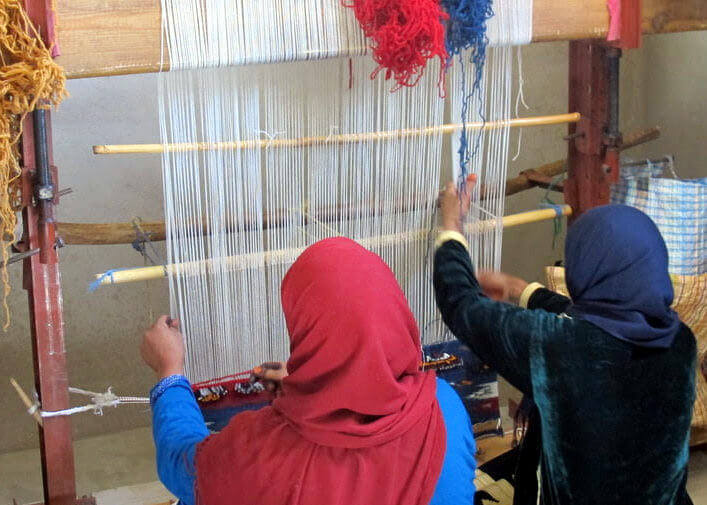
Carpet Styles:
There are as many styles of carpets in Morocco as there are tribes and villages. Each group of people have their own way of making carpets, and each artisan adds their own distinct style and artistic flair to their work. Creating a comprehensive guide to Moroccan carpets would need much more than one blog post, so here we will only look at a few popular styles that you might come across in markets and carpet shops.
There are three main techniques used in different variations in most carpets:
- Pile or knotted carpets: Short pieces of yarn are tied around the warp threads to create a shaggy, tufted surface.
- Flatweave: Yarn is woven horizontally through the warp threads in different patterns to create a flat, even surface.
- Embroidery weaving: This is an extra layer that is stitched on top of a flatweave surface to add extra texture and detailed motifs and designs.
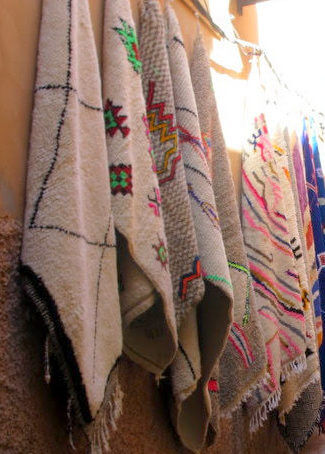
Azilal Rugs
Like most of the carpets woven in Morocco, these carpets tell stories. Stories inspired by the life of the women weavers – life events, nature, household activities, and patterns in the built environment. These themes are interpreted in simple geometric shapes and lines, creating striking abstract works of art.
These carpets were traditionally made by the women of the Azilal tribe, from the region south of Beni Mellal, to be used at home and not for commercial purposes. It only became popular outside the region during the 1990s and are now highly sought-after in Western interior design, commercial, and fine art circles.
The carpets are made from virgin wool, the first shearing of a lamb, resulting in a super-soft carpet pile. The carpet is constructed by alternating rows of knotted wool with two rows of flatweave wool. Natural undyed wool is used as the base colour and the patterns are added in brightly coloured wool dyed with natural or commercial dye.
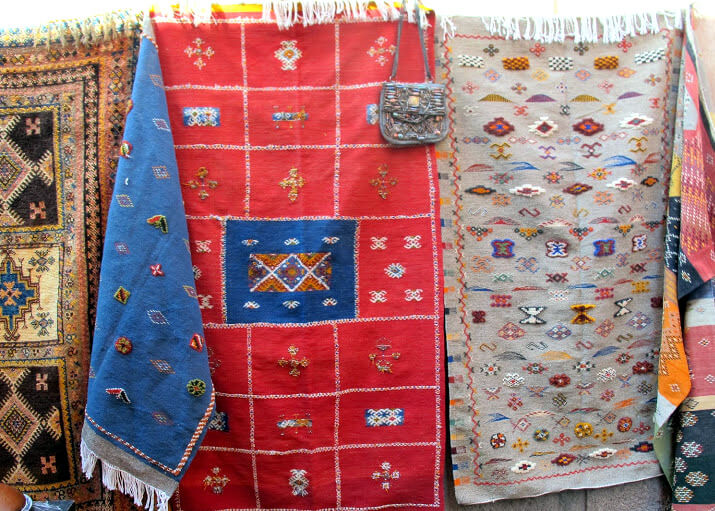
Glaoui rugs
These carpets are made by the Berber tribes from the Ouarzazate and Taznakht region in Southern Morocco. This unique style includes three different techniques in one carpet – flatweave, knotted and stitched tapestry or surface embroidery.
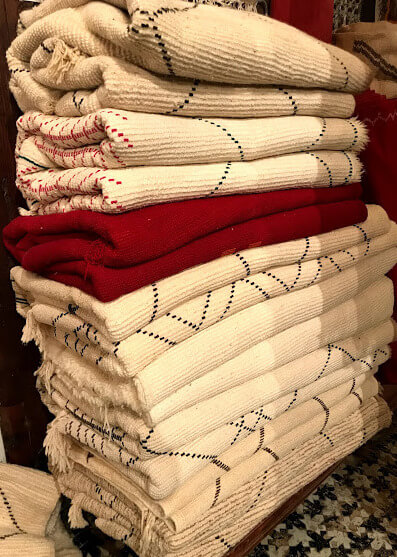
Beni Ourain carpets:
These carpets are probably the best-known Moroccan carpets outside of Morocco, as it is very popular in Western interior design circles. These carpets are traditionally made by the women of the Beni Ourain tribes living the Middle Atlas region of the country. They are traditionally sheep and goat herders and are semi-nomadic. They produce exceptionally high-quality wool which is used to produce these popular carpets.
Only natural, undyed wool are used. The light white or cream coloured wool is used as a base or background colour and the darker, still natural, wool is used to create geometric and linear patterns. Like the Azilal carpets, the Beni Ourain carpets are also made using alternating rows of knotted pile and flatweave wool.
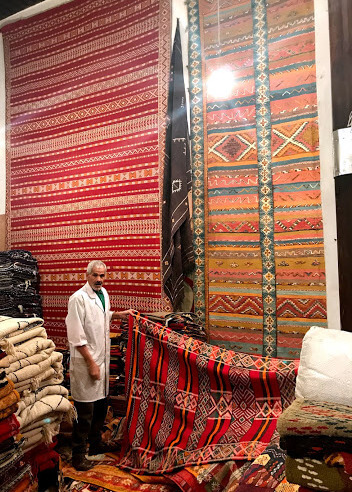
Zemmour rugs
These are flatweave carpets from the Zemmour tribal confederation located east of Rabat based around the market town of Khemmisset. These rugs are sometimes referred to as Khemmisset rugs.
These carpets have a distinct horizontal linear pattern with fine geometric designs. The base colour is often a deep red with gold, black and white designs. Both the warp and weft are made using wool, although the white is sometimes cotton or rayon.
A similar but more unusual style is called a Tiflet carpet and has a blue background. These carpets usually have a more intricate design and are often made using rayon instead of wool.
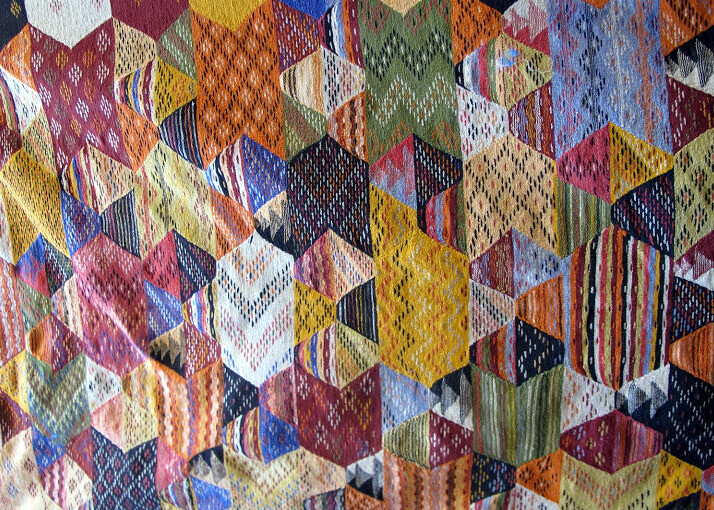
Kharita rugs
These are also known as map rugs as the distinct wavy patterns give the impression of mountains or landscapes. It is a flatweave rug with the unique feature that it is reversible. The pattern is the same on both sides of the rug. The colour palette is usually different shades of orange, yellow, green and red.
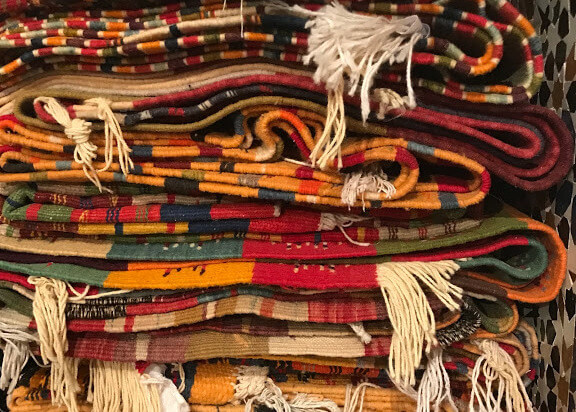
Further reading:
- For more information on the different styles of carpets, to learn more about the women who make these carpets, and to learn how to support the artisans: The Anou
- To read more about the artisans: Women Artisans of Morocco – their stories, their lives by Susan Schaefer Davis.
- For a comprehensive survey of 19th and 20th-century Moroccan rugs and textiles featuring a collection of mainly rural carpets and covers, tent-weavings, bags, trapping and garments: Moroccan Carpets by Brooke Pickering, W. Russel Pickering, and Ralph S. Yohe.

Oumaima
7 March
Such an informative post on Moroccan carpet styles! The weaving techniques and cultural significance behind each rug are truly fascinating. If you’re interested, check out https://berbercreations.com/ for their beautiful collection of authentic Moroccan rugs. Each piece tells a unique story through its patterns and colors, reflecting the rich heritage of the Berber people.